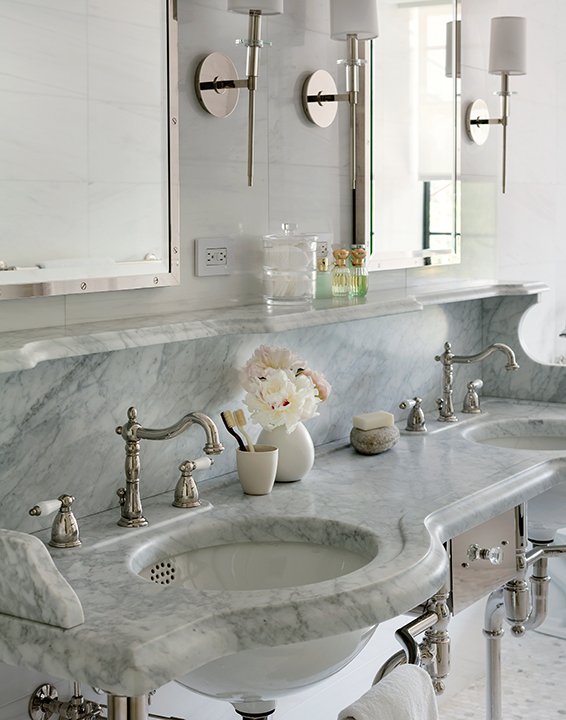Easily the main attraction in many bathrooms, a beautiful vanity is an important feature you want to get right. A stylish and functional bathroom vanity is an integral point in our days where with brush our teeth, put on makeup, and get ready for the day ahead. The question is how do you design a bathroom vanity? In this article, we’re going to give you some tips to help you choose a bathroom vanity that’s is not just stunning, but also serves your needs.
Check Your Bathroom Layout
First we need to assess the bathroom we’ll be working with. Locate where your vanity will be with respect to the other fixtures and cabinets. A single horizontal vanity is the most common choice, but you don’t have to feel limited by this. Larger bathrooms can make use of an L-shaped vanity or a galley style double vanity setup. For bathroom remodels and expansions, you also need to consider if you want to relocate your existing vanity to a better location.
Consider How Many Sinks You Need
With a general idea of where your vanity will be, next thing on the list is whether you need one sink or two. Smaller bathrooms such as powder rooms and guest baths will likely only need one. For Master Baths, many homeowners want double sink vanities. Dedicated his and her sinks helps separate personal care products and keeps things organized. Of course, this decision depends on your own personal needs. If you and your spouse don’t really need the sink simultaneously, then having just one can be enough. For some, extra counter space is more valuable than a second sink as it gives you more space to get ready for the day.
Make Sure It’s The Right Size
Next you have to consider the size of vanity you need. The first 2 tips on our list will largely determine how wide your new bathroom vanity will be. If you decided on double sinks, you’ll need a vanity wide enough to accommodate both plus some extra space to comfortably move around. On the other extreme, small spaces such as those in many New York City apartments will need a more slender vanity.
While vanities often come in standard sizes ranging from 30 to 36 inches, this is also something subject to customization. Kids’ bathrooms in particular can benefit from a lower bathroom vanity for comfort and ease of use. Do note that small children will eventually outgrow these and need a regular height counter. This won’t be an issue if you’re planning to remodel again in a few years, but it’s definitely something to consider.
The standard depth of a vanity is about 21 inches, and it’s not customized as often. When vanity depth is adjusted, it’s usually for small spaces. Bathroom vanities can be made to be as narrow as 12 inches to fit in even the tightest of spaces.
Decide on the Type of Vanity
From here, we start to think more about your vanity’s look and style. In general, your primary options are either freestanding vanities or built-in ones. A freestanding vanity is not fully attached to walls and will look like a piece of furniture. This is becoming more common especially in more contemporary bathroom styles. Built-in cabinets, on the other hand, are the more common choice for traditional bathroom styles. This option is great for those that need a lot of storage space, and it greatly maximizes wall space.
There are also other options such as floating vanities, repurposing antique furniture, or just using a pedestal sink. You should do thorough research, or consult with a design professional to figure out what type will go best with your bathroom’s design style.
Traditional style white marble double sink bathroom vanity by Wood & Co.
Choose the Right Material and Countertop
If you decided to use a pedestal sink or wall-mounted sink, you can skip this step. Otherwise, now is the time to choose a material and finish for your cabinet and countertop. The finish you choose will greatly affect the overall look and style of, not just your vanity, but your bathroom as a whole.
For the cabinet itself, wood is the primary option. You can choose to have it in a natural or stained wood finish to add an organic and earthy feel to your space. Another option is to paint it. Light colors such as white can create a bright an airy atmosphere. Darker colors like can add a touch of luxe and sophistication. You can also paint your vanity with an accent color to make it standout against your bathroom walls.
You will then need to combine this with a matching countertop. The most common options are stones such as quartz, granite, and marble. These come in a wide selection of colors and patterns that can greatly enhance your space. Wood countertops are also an option, but will require more maintenance in a high moisture environment like a bathroom.
Don’t Forget Your Doors and Hardware
The last finishing touches to your vanity are the doors and hardware, or lack thereof. Contemporary bathrooms do well using flat slab doors combined with simple or no hardware to create a clean and sleek look. Skipping the doors and going for open shelving is also great for this, with the added bonus of making your bathroom feel more spacious. On the other hand, a more traditional bathroom style would call for moulded panel doors with ornate knobs and pulls. Transitional styles will go for something in between such as a shaker style door with simple hardware.
Work With a Professional
Armed with the basic steps, we’re sure that you’re itching to get your project started. You’re probably burning with excitement, have multiple ideas and likely even more questions. When it comes to such important projects, it’s best to hire a professional.
We at Wood & Co. can assist you every step of the way. We’ve helped many designers and homeowners with their bathroom vanities on Long Island, The Hamptons, and many parts of New York City. If you’re in any of these areas, feel free to contact us and schedule a consultation. Let’s work together to create the perfect bathroom vanity for you and your home.


